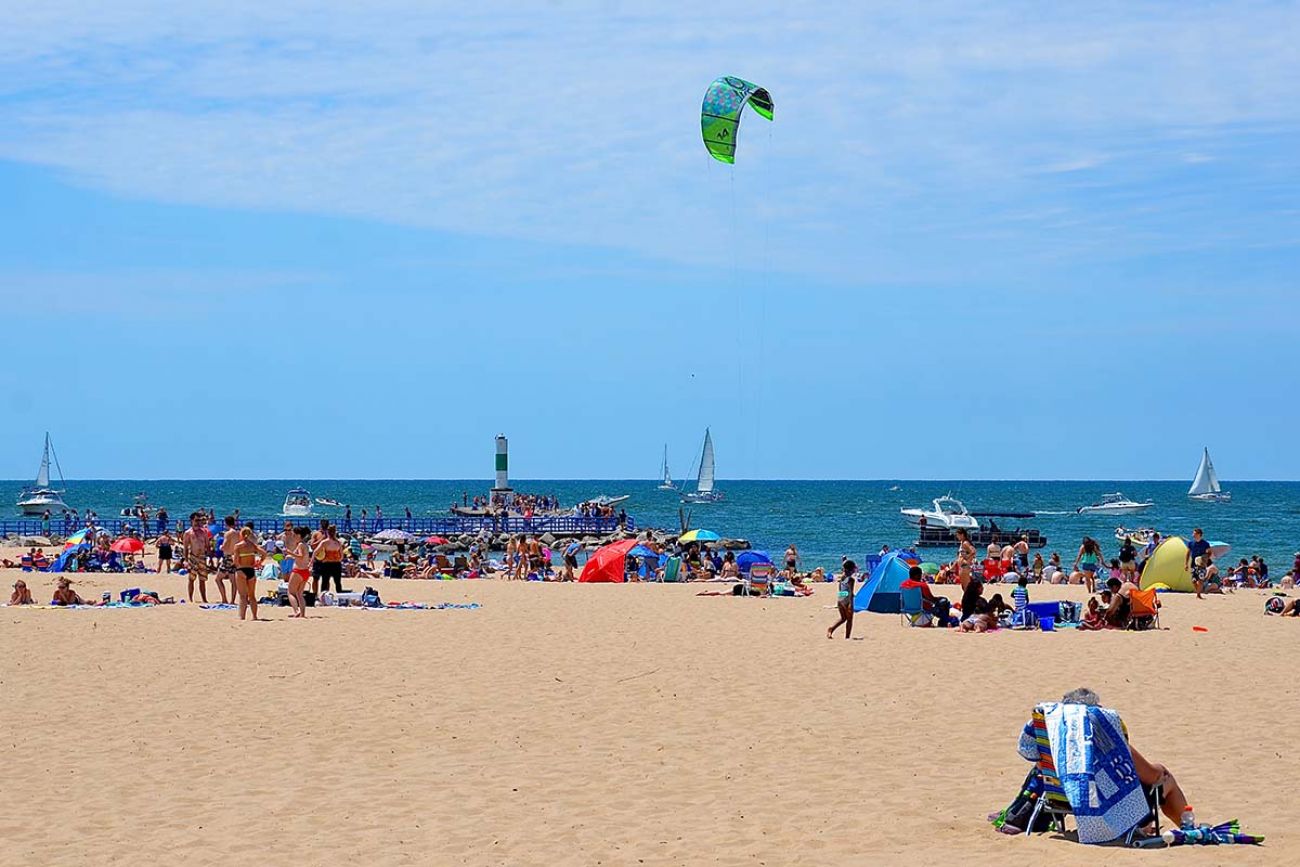As Michigan DNR camping reservations soar, parks want COVID funds soon

As the COVID-19 pandemic drives soaring demand for outdoor recreation, a looming question remains: When might overburdened state and local parks expect to see a nearly $1 billion boost in proposed funding?
Michigan state parks posted a landmark year for visitors in 2021, with a record-shattering 1.4 million camping and lodging nights and an estimated 35 million visitors. State officials expect 2022 to be at least as busy, as popular spots like Holland State Park are already fully booked for the Fourth of July weekend.
But that’s straining a system already faced with more than $250 million in deferred maintenance, leaving parks with crumbling roads, aging bathrooms and creaky electrical systems. And some city-owned park systems ─ like that in Flint ─ are so strapped for cash they dissolved their parks department and need volunteers to pick up trash.
Related:
- Michigan DNR camping reservations up 8 percent. Book now for busy sites.
- Michigan parks are popular, but underfunded. They want some COVID money.
- Michigan parks look increasingly likely to get big COVID funding boost
- Emergencies surge at northern Michigan parks, lakes. Time for a rescue tax?
“There’s obviously a lot of work that needs to be done,” said Ron Olson, state parks chief for the Michigan Department of Natural Resources. “There are state parks with bad roads, outdated sewer systems, antiquated structures. People expect a clean place at a park when they go to the bathroom and shower.”
State Republicans introduced three bills in October that would send $968 million of Michigan’s $5.8 billion in unspent COVID-19 federal stimulus dollars to state and local parks.
Senate Bill 703, sponsored by Ed McBroom, a Republican from Vulcan, in the Upper Peninsula, would target $250 million at a $264 million maintenance backlog in Michigan’s state parks, and earmark another $30 million each to the Mackinac State Historic Parks and a new “Northern Michigan tourism and sports fund.”
Senate Bill 704, sponsored by Michael MacDonald, R-Macomb, would devote $150 million for grants to help local parks systems make their own facilities upgrades. A third bill, sponsored by Sen. Jon Bumstead, R-Newaygo, would direct $508 million to fill the State Park Endowment Fund — approved in 1994 by voters as a constitutional amendment to assure state parks a stable source of funding — up to its $800 million cap.
The bills await action in the Senate Appropriations Committee, where committee chair Jim Stamas, R-Midland, expects to conduct hearings in the next couple months.
“There’s been a long period of time where we have had minimal funding for parks. It’s exciting to have that discussion,” Stamas told Bridge.
In June, Gov. Gretchen Whitmer announced her own proposal to funnel $250 million from the federal American Rescue Plan to state parks, following that with a plan to send $150 million toward local parks. She also proposed that $26 million in federal stimulus money go to develop Genesee County’s first-ever state park, at the former site of Flint’s Chevrolet plant along the Flint River.
Robert Leddy, spokesperson for Whitmer, did not return requests from Bridge Michigan seeking comment. But he said at the time the GOP bills were introduced that the governor anticipates working with the Republican-controlled Legislature to reconcile the spending proposals.
““One of our state’s greatest strengths is our pristine natural resources,” Leddy said then. “That’s why Governor Whitmer and the legislature have put forward very similar proposals to make historic investments in our state and local parks.”
Clay Summers, executive director of the Michigan Recreation and Park Association, a Lansing-based nonprofit advocacy group, said it’s unclear whether Bumstead’s proposal to send $508 million in funds to the State Park Endowment Fund meets requirements of the American Rescue Plan.
“It’s our understanding that those funds are available for infrastructure upgrades. We need to make sure that’s an acceptable use of those funds,” Summers told Bridge.
Summers noted that there’s little time for delay, since federal stimulus funds must be obligated by the end of 2024 and spent by the end of 2026.
As Bridge Michigan has reported, state and local parks have long struggled for funds to keep pace with basic maintenance, a reality that has left grass uncut, pavement cracked and buildings and equipment in sore need of repair or replacement.
The pandemic only added to the wear and tear at parks and campgrounds, as camping nights at state parks jumped 36 percent and by more than 300,000 visitors in 2021 as people sought escape to outdoor recreation settings amid a stifling pandemic. It’s been a trend across the country, as national parks from Yellowstone to the Great Smoky Mountains posted record numbers of visitors in 2021.
The state drastically peeled back financial support for state parks in the early 2000s amid an economic recession and plunging state revenues. Annual capital spending on parks fell from $16 million in fiscal 2003-2004 to less than $1.5 million just three years later. The Department of Natural Resources effectively halted crucial parks capital improvement projects as it channeled nearly all funding into operations.
Money to run Michigan’s 103 state parks has steadily inched up since the state established its $11 annual recreation passport in 2010, from about $48 million in fiscal year 2011 to about $80 million in 2021. But that’s not been nearly enough to compensate for a decade or more of neglect at state parks.
State parks chief Olson singled out one such park, Algonac State Park northeast of Detroit along Lake St. Clair.
It needs $2.5 million in work, including an upgrade of restrooms and showers, reconstruction of crumbling roads, an update to its electrical and sanitation systems and a new registration office.
“It has bad roads, the plumbing in the support facility is antiquated, it needs a new electrical system,” Olson said.
At two other state parks, Olson said, campground electrical systems depend on 30-amp circuit breakers that aren’t up to the needs of power-hungry modern recreational vehicles.
“The circuit breakers will overheat and kick out, and then the power will go down in a campsite or in a campground loop. It’s even to the point where we will have to put fans up to keep the breakers cool on a hot summer day.”
At the same time, city and county park systems were easy targets for cuts when municipalities and county governments slashed spending during the Great Recession from 2007 to 2009 and its aftermath.
In Genesee County, parks director Barry June said the county park system has managed to keep its head just above water, thanks to a 0.5-mill county property tax levy.
But June said there are millions of dollars in projects he’d like to get to — but can’t, with an annual maintenance budget of $600,000.
“It’s not one thing, it’s death by a thousand cuts,” June told Bridge.
“We have two parks built by the (U.S. Civilian Conservation Corps) in the 1930s. There is a very large pavilion with tree trunk posts and the posts are rotting away. That’s going to be, who knows, $300,000. We need new bathrooms at another campground. That’s about $1.2 million.”
In Flint, the challenges are steeper — perhaps beyond what cash for infrastructure upgrades can fix.
In 2010, the University Michigan-Flint completed an assessment of the city’s parks system, rating 38 of its 62 parks in “poor” or “mediocre” condition. The survey found parks rife with trash and dead trees and evidence of vandalism, drug activity or "sex paraphernalia.”
The number of city park workers fell from 95 in 2002 to just a handful a few years later, until the city disbanded its parks department in 2013.
Bridge reached out to city officials in Flint for comment about the state of its park system, but received no response.
Genesee County now helps maintain Flint’s larger parks, while the city pays contractors to mow the grass — and relies on hundreds of volunteers to pick up trash once a week at a designated park.
That work is overseen by a program called Keep Genesee County Beautiful, funded at about $390,000 a year through the Ruth Mott Foundation, a Flint philanthropy.
Nancy Edwards, grants officer for the program, credits volunteers “with an amazing job. They do their absolute best.”
Edwards also noted that a variety of grants in recent years have funded replacement of aging playground equipment at many of Flint’s parks.
But Edwards said the volunteer maintenance program has its limits. On occasion, there are parks with no assigned volunteers. A volunteer may have a family emergency, and miss a turn or two.
“That trash may pile up in a park for days or weeks,” she said. “Flint residents deserve better. None of us like to look outside our door and see trash piling up. But most of us don’t have to deal with that because we live in places that can expect city services.”
Flint’s 0.5-mill tax for city parks generates less than $350,000 a year and Edwards estimates the city needs at least $1.5 million a year to properly maintain the system. Even federal stimulus funds can’t patch that hole.
“The bigger question here is how do you fund parks for the long term. That’s the harder part.”
Michigan Environment Watch
Michigan Environment Watch examines how public policy, industry, and other factors interact with the state’s trove of natural resources.
- See full coverage
- Subscribe
- Share tips and questions with Bridge environment reporter Kelly House
Michigan Environment Watch is made possible by generous financial support from:
Our generous Environment Watch underwriters encourage Bridge Michigan readers to also support civic journalism by becoming Bridge members. Please consider joining today.
See what new members are saying about why they donated to Bridge Michigan:
- “In order for this information to be accurate and unbiased it must be underwritten by its readers, not by special interests.” - Larry S.
- “Not many other media sources report on the topics Bridge does.” - Susan B.
- “Your journalism is outstanding and rare these days.” - Mark S.
If you want to ensure the future of nonpartisan, nonprofit Michigan journalism, please become a member today. You, too, will be asked why you donated and maybe we'll feature your quote next time!






